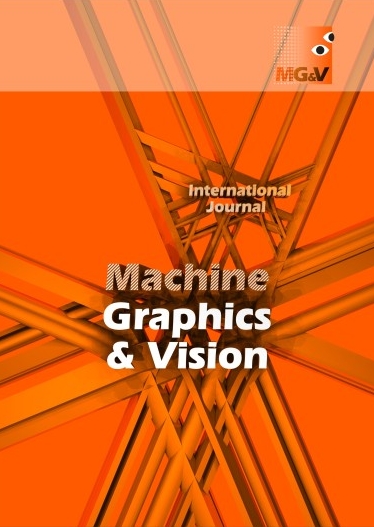Main Article Content
This paper investigates the relationship between colorization and pseudo-colorization techniques for converting grayscale images to color. Colorization strives to create visually believable color versions of monochrome images, either replicating the original colors or generating realistic, alternative color schemes. In contrast, pseudo-colorization maps grayscale intensities to pre-defined color palettes to improve visual appeal, enhance content understanding, or aid visual analysis. While colorization is an ill-posed problem with infinitely many RGB solutions, pseudo-colorization relies on mapping functions to deterministically assign colors. This work bridges these techniques by exploring the two following operations: first - deriving pseudo-color from colorized images - this allows for creating stylized or abstract representations from existing colorizations, and second - enriching color diversity in pseudo-colored images - this enhances visual appeal and attractiveness of pseudo-colored images. The paper emphasizes the centrality of decolorization (rgb-to-gray) models in both processes. It focuses on the theoretical underpinnings of these problems but complements them with illustrative examples for clarity.
Article Details
B. Abidi, Y. Zheng, A. Gribok, and M. Abidi. Screener evaluation of pseudo-colored single energy X-ray luggage images. In: Proc. 2005 IEEE Computer Society Conference on Computer Vision and Pattern Recognition (CVPR'05) - Workshops, pp. 35-35, 07 2005. https://doi.org/10.1109/CVPR.2005.521. (Crossref)
R. C. Contreras, O. Morandin Junior, and M. S. Viana. A new local search adaptive genetic algorithm for the pseudo-coloring problem. In: Y. Tan, Y. Shi, and M. Tuba, eds., Advances in Swarm Intelligence, pp. 349-361. Springer International Publishing, 2020. https://doi.org/10.1007/978-3-030-53956-6_31. (Crossref)
E. Farella, S. Malek, and F. Remondino. Colorizing the past: Deep learning for the automatic colorization of historical aerial images. Journal of Imaging, 8:269, 10 2022. https://doi.org/10.3390/jimaging8100269. (Crossref)
K. Fishkin and B. Barsky. An analysis and algorithm for filling propagation. In: Computer-Generated Images. The State of the Art Proceedings of Graphics Interface ’85, pp. 56-76. Springer, 1985. https://doi.org/10.1007/978-4-431-68033-8_6. (Crossref)
R. Gupta, A. Chia, D. Rajan, E. Ng, and Z. Huang. Image colorization using similar images. In: Proc. 20th ACM Int. Conf. on Multimedia (MM'12), pp. 369-378, 2012. https://doi.org/10.1145/2393347.2393402. (Crossref)
S. Iizuka, E. Simo-Serra, and H. Ishikawa. Let there be color!: joint end-to-end learning of global and local image priors for automatic image colorization with simultaneous classification. ACM Transactions on Graphics, 35:1-11, 07 2016. https://doi.org/10.1145/2897824.2925974. (Crossref)
R. Irony, D. Cohen-Or, and D. Lischinski. Colorization by example. In: Proc. Eurographics Symposium on Rendering (2005). The Eurographics Association, 2005. https://doi.org/10.2312/EGWR/EGSR05/201-210.
ITU-R. Parameter values for the HDTV standards for production and international programme exchange. Recommendation BT.709-6, International Telecommunication Union, Geneva, 2015. https://www.itu.int/rec/R-REC-BT.709-6-201506-I/.
M. Khan, Y. Gotoh, and N. Nida. Medical image colorization for better visualization and segmentation. In: M. Valdés Hernández and V. González-Castro, eds., Medical Image Understanding and Analysis, pp. 571-580. Springer International Publishing, 2017. https://doi.org/10.1007/978-3-319-60964-5_50. (Crossref)
C. Lei and Q. Chen. Fully automatic video colorization with self-regularization and diversity. In: Proc. 2019 IEEE/CVF Conference on Computer Vision and Pattern Recognition (CVPR), pp. 3748-3756, 2019. https://doi.org/10.1109/CVPR.2019.00387. (Crossref)
A. Levin, D. Lischinski, and Y. Weiss. Colorization using optimization. ACM Transactions on Graphics, 23:689-694, 06 2004. https://doi.org/10.1145/1015706.1015780. (Crossref)
K. Moreland. Why we use bad color maps and what you can do about it. In: Proc. IS&T Int. Symp. Electronic Imaging: Human Vision and Electronic Imaging, vol. 28, 2016. https://doi.org/10.2352/ISSN.2470-1173.2016.16.HVEI-133. (Crossref)
A. Popowicz and B. Smolka. Fast image colourisation using the isolines concept. Multimedia Tools and Applications, 75:15987-16009, 2017. https://doi.org/10.1007/s11042-016-3892-2. (Crossref)
K. Radlak and B. Smolka. Visualization enhancement of segmented images using genetic algorithm. In: Proc. 2014 Int. Conf. Multimedia Computing and Systems (ICMCS), pp. 391-396, 2014. https://doi.org/10.1109/ICMCS.2014.6911269. (Crossref)
A. Rahimian, M. Etehadtavakol, M. Moslehi, and E. Ng. Comparing different algorithms for the pseudo-coloring of myocardial perfusion single-photon emission computed tomography images. Journal of Imaging, 8(12):331, 12 2022. https://doi.org/10.3390/jimaging8120331. (Crossref)
A. Salmona, L. Bouza, and J. Delon. Deoldify: A review and implementation of an automatic colorization method. Image Processing On Line, 12:347-368, 2022. https://doi.org/10.5201/ipol.2022.403. (Crossref)
X.-Q. Shi, P. Sällström, and U. Welander. A color coding method for radiographic images. Image and Vision Computing, 20:761-767, 2002. https://doi.org/10.1016/S0262-8856(02)00045-8. (Crossref)
J. Su, H. Chu, and J. Huang. Instance-aware image colorization. In: Proc. 2020 IEEE/CVF Conf. Computer Vision and Pattern Recognition (CVPR), pp. 7965-7974, jun 2020. https://doi.org/10.1109/CVPR42600.2020.00799. (Crossref)
D. Varga and T. Sziranyi. Fully automatic image colorization based on convolutional neural network. In: Proc. 23rd Int. Conf. Pattern Recognition (ICPR), pp. 3691-3696, 2016. https://doi.org/10.1109/ICPR.2016.7900208. (Crossref)
A. Visvanathan, S. Reichenbach, and Q. Tao. Gradient-based value mapping for pseudocolor images. Journal of Electronic Imaging, 16(3):033004, 2007. https://doi.org/10.1117/1.2778426. (Crossref)
J. Xiao, J. Hays, K. Ehinger, A. Oliva, and A. Torralba. Sun database: Large-scale scene recognition from abbey to zoo. In: Proc. 2010 IEEE Conference CVPR, pp. 3485-3492, 2010. https://doi.org/10.1109/CVPR.2010.5539970. (Crossref)
I. Zeger, S. Grgic, J. Vukovic, and G. Sisul. Grayscale image colorization methods: Overview and evaluation. IEEE Access, 9:113326-113346, 2021. https://doi.org/10.1109/ACCESS.2021.3104515. (Crossref)
R. Zhang, P. Isola, and A. Efros. Colorful image colorization. In: Proc. European Cong. Computer Vision - ECCV 2016, pp. 649-666. Springer, 2016. https://doi.org/10.1007/978-3-319-46487-9_40. (Crossref)
A. Śluzek. Do we always need AI for image colorization? Progress in Polish Artificial Intelligence Research 4. Proc. of 4th Polish Conference on Artificial Intelligence, pp. 31-36, 2023. TUL Press, Łódź 2023. https://doi.org/10.34658/9788366741928.3.
A. Śluzek. On unguided automatic colorization of monochrome images. In: WSCG 2023 Proceedings, vol. 3301 of Computer Science Research Notes, pp. 379-384, May 2023. https://doi.org/10.24132/CSRN.3301.38. (Crossref)
A. Śluzek, M. Dudziński, and T. Świsłocki. Automatic colorization of digital movies using decolorization models and SSIM index. In: Preproc. 18th Conf. Computer Science and Intelligence Systems (FedCSIS 2023), pp. 837-847, September 2023. https://doi.org/10.15439/2023F3017. (Crossref)





